Abstract
The cytotoxic T-cell response induced by primary Epstein-Barr virus (EBV) infection and detectable in the blood of infectious mononucleosis (IM) patients shows several unusual features when tested in in vitro assays. Lysis of EBV-transformed target lines occurs with no apparent HLA restriction, and the putative EBV specificity of the response has been seriously questioned. In the present work we show that the primary T-cell response in IM is polyclonal and indeed does contain a virus-specific HLA class I antigen-restricted component, which can be selectively expanded in vitro in the presence of appropriate stimulator cells and IL-2. This allows functional analysis of the virus-specific component of the response in the absence of co-resident reactivities. Studies on blood samples taken from individuals in the acute phase of IM and again post-convalescence suggest that functionally similar populations of HLA class I-restricted cytotoxic T cells are involved in the control of both the primary and persistent phase of EBV infection.
Full text
PDF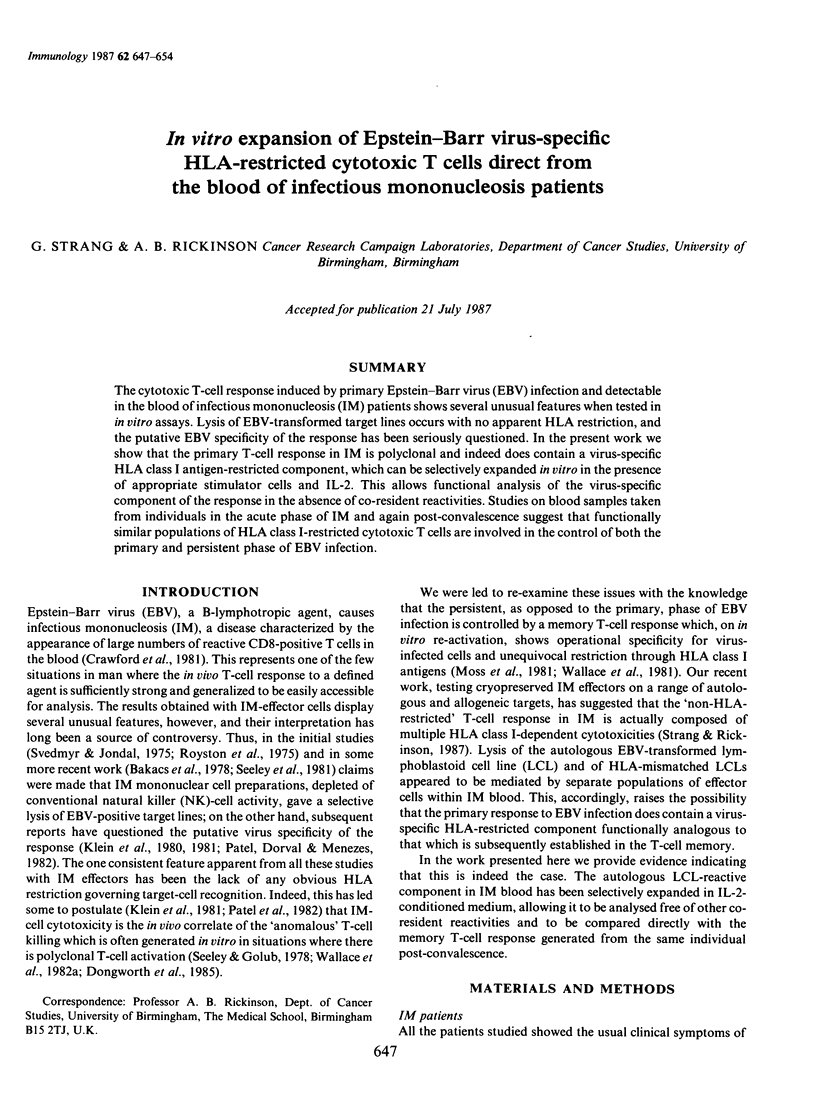
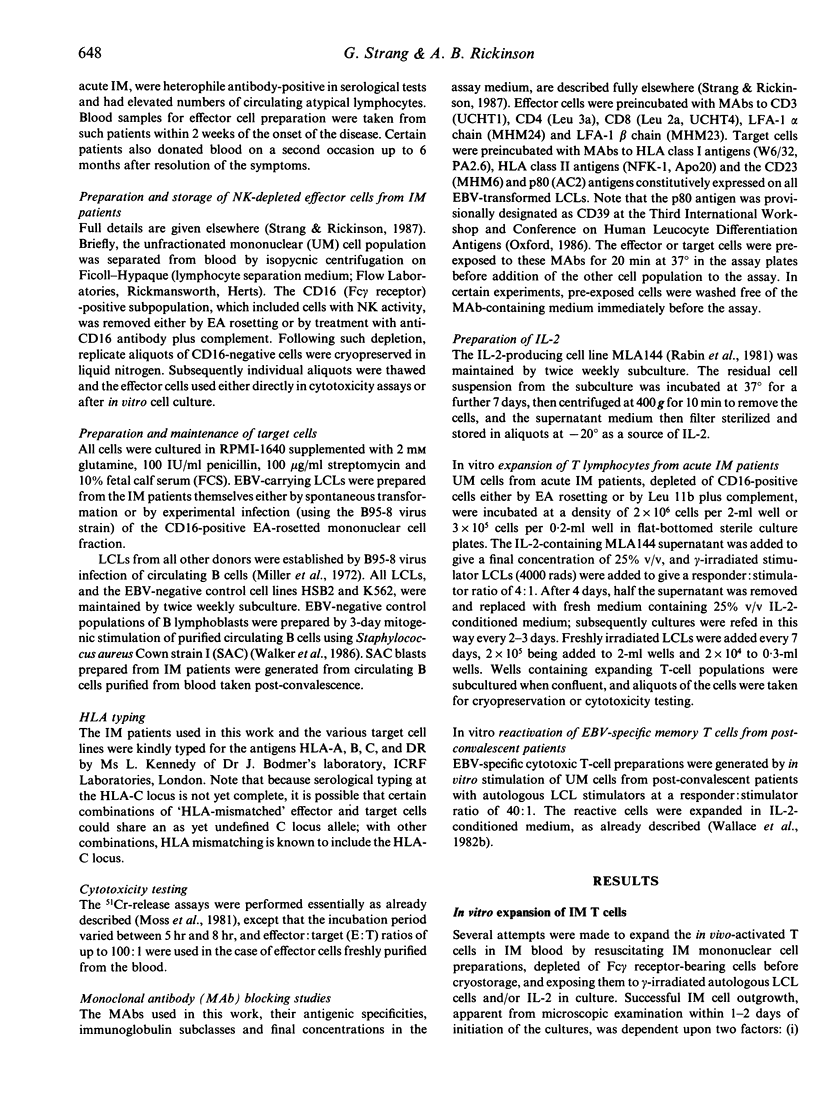
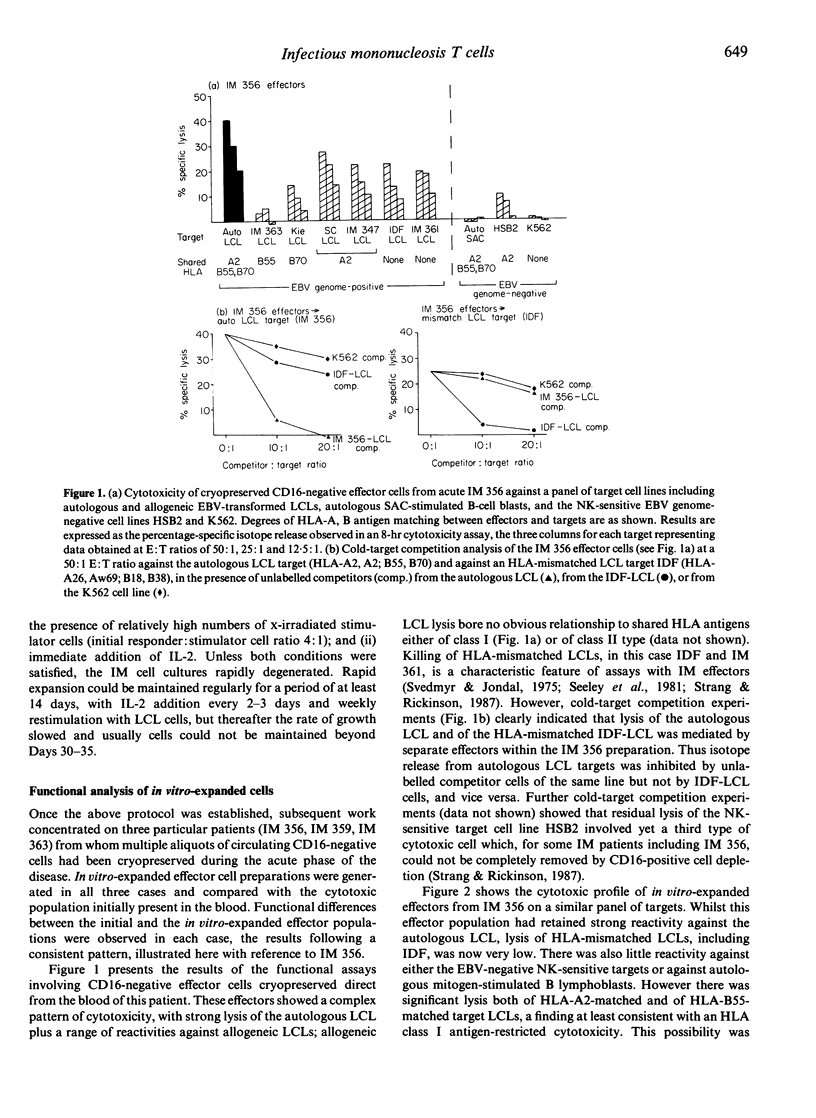
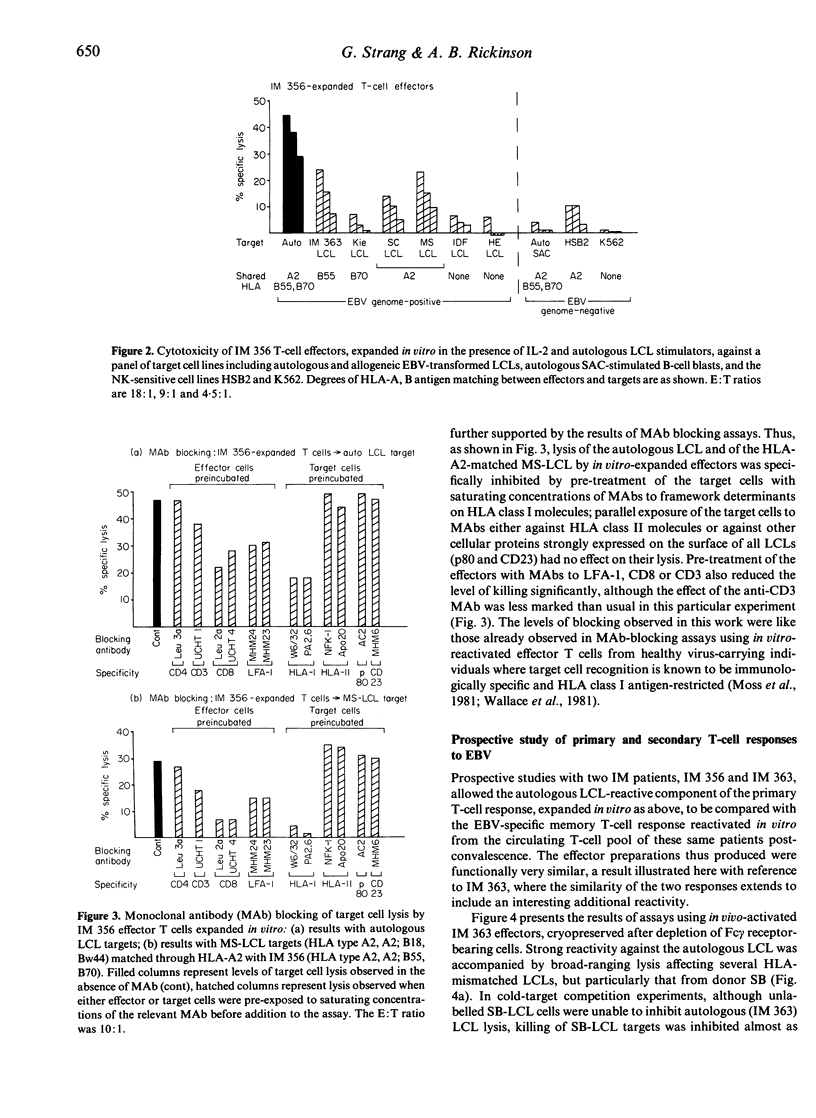
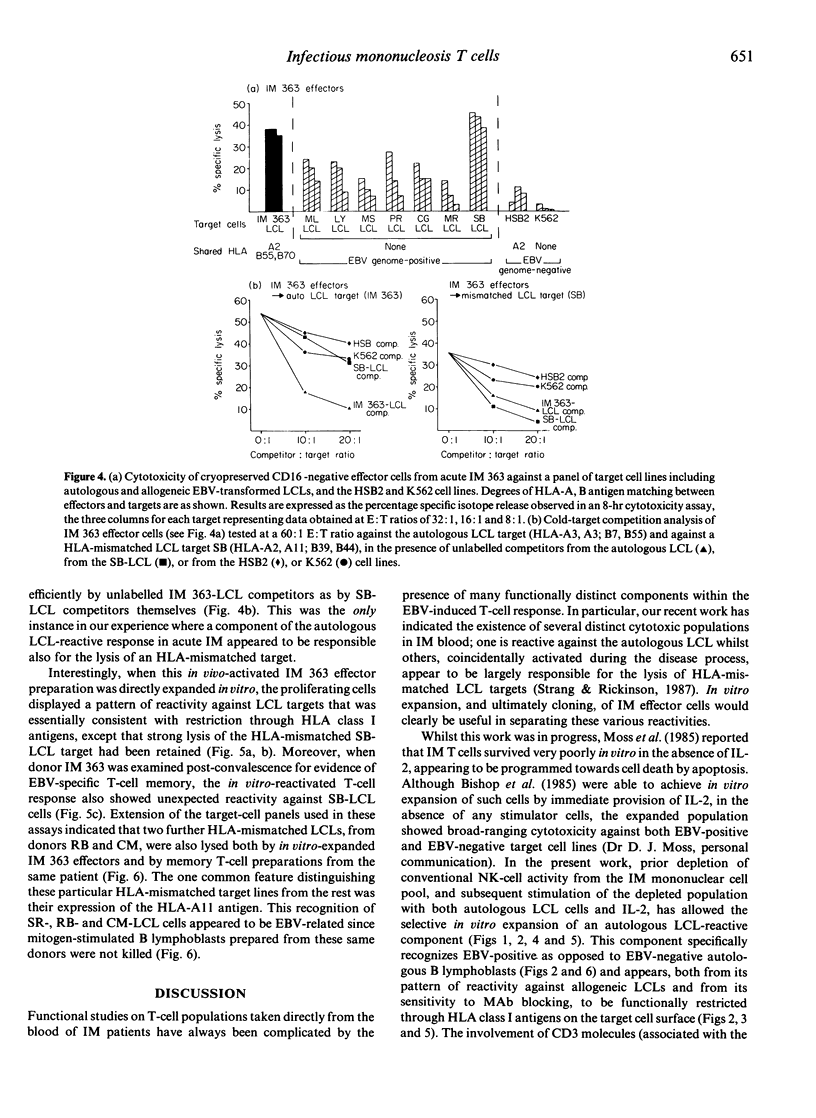
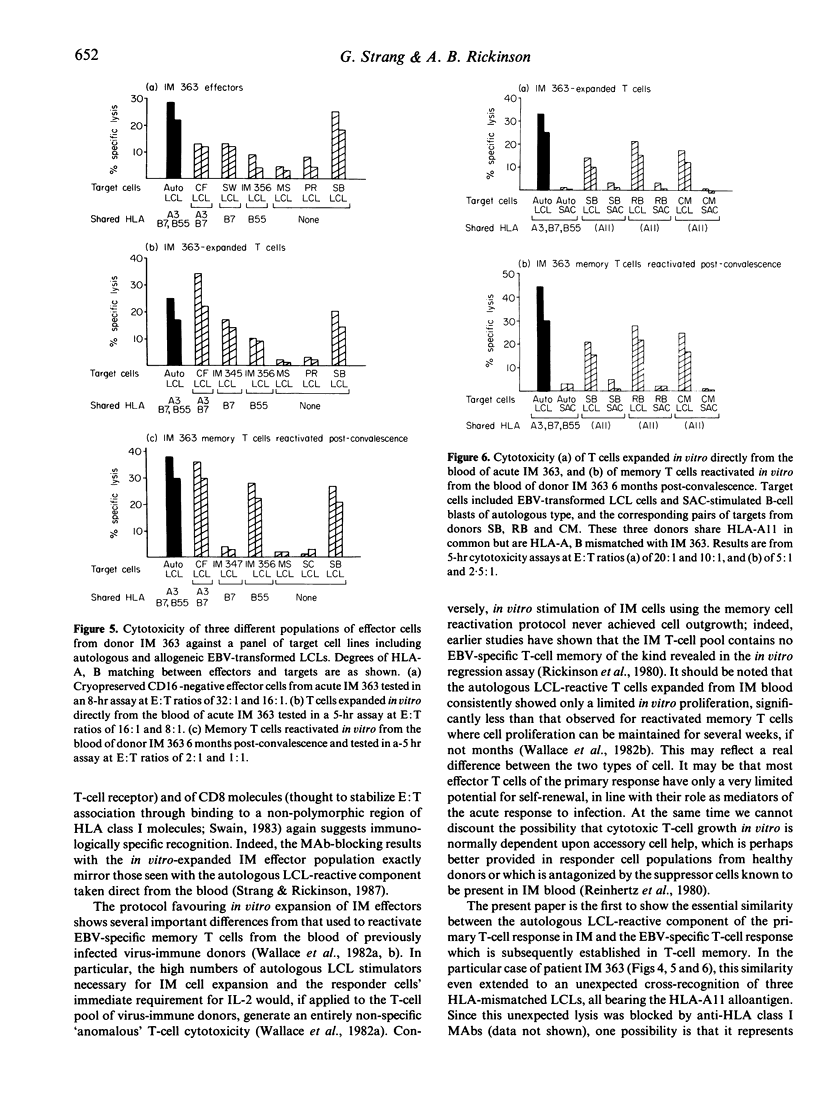
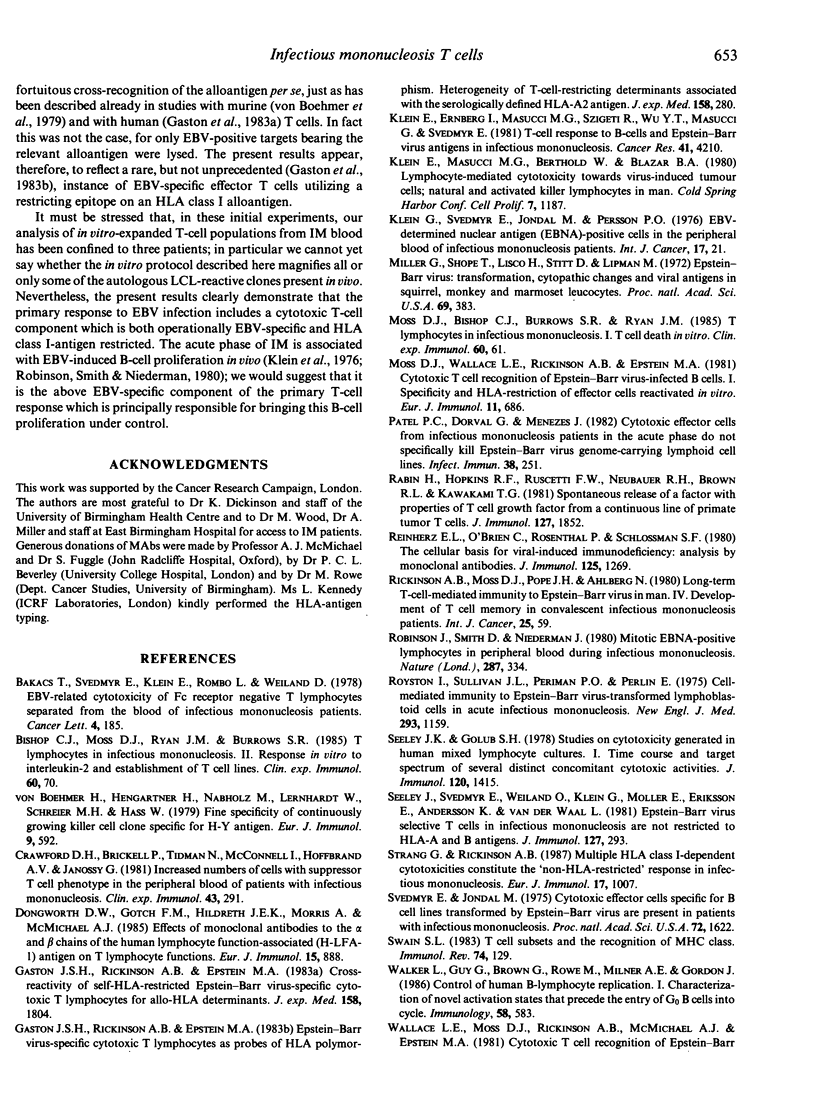

Selected References
These references are in PubMed. This may not be the complete list of references from this article.
- Bakacs T., Svedmyr E., Klein E. EBV-related cytotoxicity of Fc receptor negative T lymphocytes separated from the blood of infectious mononucleosis patients. Cancer Lett. 1978 Apr;4(4):185–189. doi: 10.1016/s0304-3835(78)94347-1. [DOI] [PubMed] [Google Scholar]
- Bishop C. J., Moss D. J., Ryan J. M., Burrows S. R. T lymphocytes in infectious mononucleosis. II. Response in vitro to interleukin-2 and establishment of T cell lines. Clin Exp Immunol. 1985 Apr;60(1):70–77. [PMC free article] [PubMed] [Google Scholar]
- Crawford D. H., Brickell P., Tidman N., McConnell I., Hoffbrand A. V., Janossy G. Increased numbers of cells with suppressor T cell phenotype in the peripheral blood of patients with infectious mononucleosis. Clin Exp Immunol. 1981 Feb;43(2):291–297. [PMC free article] [PubMed] [Google Scholar]
- Dongworth D. W., Gotch F. M., Hildreth J. E., Morris A., McMichael A. J. Effects of monoclonal antibodies to the alpha and beta chains of the human lymphocyte function-associated (H-LFA-1) antigen on T lymphocyte functions. Eur J Immunol. 1985 Sep;15(9):888–892. doi: 10.1002/eji.1830150905. [DOI] [PubMed] [Google Scholar]
- Gaston J. S., Rickinson A. B., Epstein M. A. Cross-reactivity of self-HLA-restricted Epstein-Barr virus-specific cytotoxic T lymphocytes for allo-HLA determinants. J Exp Med. 1983 Dec 1;158(6):1804–1821. doi: 10.1084/jem.158.6.1804. [DOI] [PMC free article] [PubMed] [Google Scholar]
- Gaston J. S., Rickinson A. B., Epstein M. A. Epstein-Barr virus-specific cytotoxic T lymphocytes as probes of HLA polymorphism. Heterogeneity of T cell-restricting determinants associated with the serologically defined HLA-A2 antigen. J Exp Med. 1983 Aug 1;158(2):280–293. doi: 10.1084/jem.158.2.280. [DOI] [PMC free article] [PubMed] [Google Scholar]
- Klein E., Ernberg I., Masucci M. G., Szigeti R., Wu Y. T., Masucci G., Svedmyr E. T-cell response to B-cells and Epstein-Barr virus antigens in infectious mononucleosis. Cancer Res. 1981 Nov;41(11 Pt 1):4210–4215. [PubMed] [Google Scholar]
- Miller G., Shope T., Lisco H., Stitt D., Lipman M. Epstein-Barr virus: transformation, cytopathic changes, and viral antigens in squirrel monkey and marmoset leukocytes. Proc Natl Acad Sci U S A. 1972 Feb;69(2):383–387. doi: 10.1073/pnas.69.2.383. [DOI] [PMC free article] [PubMed] [Google Scholar]
- Moss D. J., Bishop C. J., Burrows S. R., Ryan J. M. T lymphocytes in infectious mononucleosis. I. T cell death in vitro. Clin Exp Immunol. 1985 Apr;60(1):61–69. [PMC free article] [PubMed] [Google Scholar]
- Moss D. J., Wallace L. E., Rickinson A. B., Epstein M. A. Cytotoxic T cell recognition of Epstein-Barr virus-infected B cells. I. Specificity and HLA restriction of effector cells reactivated in vitro. Eur J Immunol. 1981 Sep;11(9):686–693. doi: 10.1002/eji.1830110904. [DOI] [PubMed] [Google Scholar]
- Patel P. C., Dorval G., Menezes J. Cytotoxic effector cells from infectious mononucleosis patients in the acute phase do not specifically kill Epstein-Barr virus genome-carrying lymphoid cell lines. Infect Immun. 1982 Oct;38(1):251–259. doi: 10.1128/iai.38.1.251-259.1982. [DOI] [PMC free article] [PubMed] [Google Scholar]
- Rabin H., Hopkins R. F., 3rd, Ruscetti F. W., Neubauer R. H., Brown R. L., Kawakami T. G. Spontaneous release of a factor with properties of T cell growth factor from a continuous line of primate tumor T cells. J Immunol. 1981 Nov;127(5):1852–1856. [PubMed] [Google Scholar]
- Reinherz E. L., O'Brien C., Rosenthal P., Schlossman S. F. The cellular basis for viral-induced immunodeficiency: analysis by monoclonal antibodies. J Immunol. 1980 Sep;125(3):1269–1274. [PubMed] [Google Scholar]
- Robinson J., Smith D., Niederman J. Mitotic EBNA-positive lymphocytes in peripheral blood during infectious mononucleosis. Nature. 1980 Sep 25;287(5780):334–335. doi: 10.1038/287334a0. [DOI] [PubMed] [Google Scholar]
- Royston I., Sullivan J. L., Periman P. O., Perlin E. Cell-mediated immunity to Epstein-Barr-virus-transformed lymphoblastoid cells in acute infectious mononucleosis. N Engl J Med. 1975 Dec 4;293(23):1159–1163. doi: 10.1056/NEJM197512042932301. [DOI] [PubMed] [Google Scholar]
- Seeley J. K., Golub S. H. Studies on cytotoxicity generated in human mixed lymphocyte cultures. I. Time course and target spectrum of several distinct concomitant cytotoxic activities. J Immunol. 1978 Apr;120(4):1415–1422. [PubMed] [Google Scholar]
- Seeley J., Svedmyr E., Weiland O., Klein G., Moller E., Eriksson E., Andersson K., van der Waal L. Epstein Barr virus selective T cells in infectious mononucleosis are not restricted to HLA-A and B antigens. J Immunol. 1981 Jul;127(1):293–300. [PubMed] [Google Scholar]
- Strang G., Rickinson A. B. Multiple HLA class I-dependent cytotoxicities constitute the "non-HLA-restricted" response in infectious mononucleosis. Eur J Immunol. 1987 Jul;17(7):1007–1013. doi: 10.1002/eji.1830170717. [DOI] [PubMed] [Google Scholar]
- Svedmyr E., Jondal M. Cytotoxic effector cells specific for B Cell lines transformed by Epstein-Barr virus are present in patients with infectious mononucleosis. Proc Natl Acad Sci U S A. 1975 Apr;72(4):1622–1626. doi: 10.1073/pnas.72.4.1622. [DOI] [PMC free article] [PubMed] [Google Scholar]
- Swain S. L. T cell subsets and the recognition of MHC class. Immunol Rev. 1983;74:129–142. doi: 10.1111/j.1600-065x.1983.tb01087.x. [DOI] [PubMed] [Google Scholar]
- Walker L., Guy G., Brown G., Rowe M., Milner A. E., Gordon J. Control of human B-lymphocyte replication. I. Characterization of novel activation states that precede the entry of G0 B cells into cycle. Immunology. 1986 Aug;58(4):583–589. [PMC free article] [PubMed] [Google Scholar]
- Wallace L. E., Moss D. J., Rickinson A. B., McMichael A. J., Epstein M. A. Cytotoxic T cell recognition of Epstein-Barr virus-infected B cells. II. Blocking studies with monoclonal antibodies to HLA determinants. Eur J Immunol. 1981 Sep;11(9):694–699. doi: 10.1002/eji.1830110905. [DOI] [PubMed] [Google Scholar]
- Wallace L. E., Rickinson A. B., Rowe M., Moss D. J., Allen D. J., Epstein M. A. Stimulation of human lymphocytes with irradiated cells of the autologous Epstein-Barr virus-transformed cell line. I. Virus-specific and nonspecific components of the cytotoxic response. Cell Immunol. 1982 Feb;67(1):129–140. doi: 10.1016/0008-8749(82)90205-2. [DOI] [PubMed] [Google Scholar]
- Wallace L. E., Rowe M., Gaston J. S., Rickinson A. B., Epstein M. A. Cytotoxic T cell recognition of Epstein-Barr virus-infected B cells. III. Establishment of HLA-restricted cytotoxic T cell lines using interleukin 2. Eur J Immunol. 1982 Dec;12(12):1012–1018. doi: 10.1002/eji.1830121206. [DOI] [PubMed] [Google Scholar]
- von Boehmer H., Hengartner H., Nabholz M., Lernhardt W., Schreier M. H., Haas W. Fine specificity of a continuously growing killer cell clone specific for H-Y antigen. Eur J Immunol. 1979 Aug;9(8):592–597. doi: 10.1002/eji.1830090804. [DOI] [PubMed] [Google Scholar]


